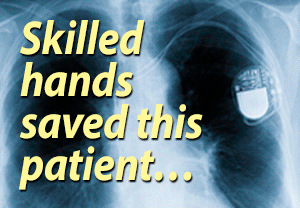 Atrial lead only
Atrial lead only
- by Angelie
- 2009-02-20 10:02:50
- Batteries & Leads
- 2227 views
- 5 comments
Anyone else out there only have one lead that's placed in the Atrium. I was told by my pacemaker technician that this lead placement is extremely rare in the US.
Just looking for confirmation.
Thanks,
Angelie
5 Comments
one lead
by bambi - 2009-02-20 11:02:15
I think the technician may have said that because some people need most of their pacing in the atrium and very little to none in the ventricles. However, most Dr.'s will go ahead and place a lead in the ventricle anyway. I have 2 leads and pace 98-100% in the atrium and only 4-8% in the ventricle. I've heard that most people with one lead end up having a second lead placed at a later time. But, let me say, I'm certainly no expert! Maybe someone else can answer this better.
Bambi
That's precisely my point, Bambi
by Angelie - 2009-02-20 11:02:42
Yep, MOST people have 1 lead in the ventricle, or 2 leads (one in the atrium, one in the ventricle)
I have ONE lead in the atrium only. Just trying to look for others so I don't feel quite so much like an "oddity". I mean, this configuration....the way I see it, has the possibility to really make things confusing which scares me in time of emergencies when seconds matter.
So far, it's messing everyone up. I think my own health care team even forget that my lead is in my atrium and not in my ventricle- it's that odd, at least from what I know now.
Hopefully, others will be able to enlighten me a bit.
DOES HAVE ADVANTAGES
by pete - 2009-02-21 03:02:19
Single lead- Single pass pacing of the Atrium if safe and not uncommon. It has distinct advantages. Only 1 lead instead of 2. Lower costs / complications. This however is only cosidered if you need predominantly Atrial pacing. I expect they are using overlapping biphasic impulse stimulation ( OLBI) to aviod diaphram stimulation and to insure sucessful capture of the atrial myocardium. Happy Pacing . Cheers Peter
Pacemakers
by SMITTY - 2009-02-21 09:02:24
Hello Angelie,
The following is part of an article from www.heartpoint.com on why single lead or multiple lead pacemakers are preferred for a particular patient. This may give you a little insight as to why you got a single lead pacemaker. Or at the least it may give you some questions to ask your doctor.
Good luck with your continuing education on pacemakers.
Smitty
What kind of pacemakers are there?
Several kinds are used. Most of the devices implanted today are for correcting rhythms that are too slow, and are discussed below. Pacemaker leads may be placed in the atrium alone, the ventricle alone, or in both the atrium and ventricle depending on the situation.
Single lead pacemakers are used primarily in four situations:
1. When the only problem is with the formation of the initial impulse in the atrium, simply placing a lead in the right atrium will "start things off" when it's needed, and the electrical impulse will then continue normally through the rest of the atrium, the AV node and the ventricles.
2. When the patient is in chronic atrial fibrillation and the ventricle is going too slow atrial fibrillation. In this case, only a single lead is placed in the ventricle (because the fibrillating atrium cannot be paced).
3. When the problem with a slow rate occurs only occasionally and for relatively brief periods of time, a single lead in the ventricle may be all that is utilized to provide brief help at those times.
4. A special lead which can sense in both chambers, and pace only in the ventricle is also useful in some situations, and is discussed below.
"Dual chamber" devices (with one lead in the right atrium and one in the right ventricle) are desirable in many situations. Such devices keep the upper and lower chambers contracting in their proper sequence.
A fairly recent development is a single lead that paces only the ventricle, but senses both chambers. In this device, a sensing ring is on the lead at the level of the atrium, which can sense the atrium's activity. The ventricle is sensed in the usual way, via the contact of the lead with the muscle. This device is particularly useful in situations where the sinus node is beating fast enough, but there is a block in the propagation of the impulse to the rest of the heart muscle.
The earliest pacemakers did not sense if the heart was making any impulses on their own, and were described as "fixed rate" pacemakers. These are simply not made any longer, and current devices are described as "demand" models, pacing the heart only when needed.
A rate response feature that distinguishes different types of pacemakers is their ability to respond to a person's activity, going faster when the person is active, and slower when inactive.
You know you're wired when...
You have a T-shirt that reads Wired4Sound.
Member Quotes
I wouldn't be here if it were not for this amazing technology inside of me.

.png)



Somebody........
by Angelie - 2009-02-20 04:02:47
Anybody? Is there anybody out there? Hello, hello.? ¿Hay cualquier persona hacia fuera allí?
Y a-t-il n'importe qui dehors là ?
¿Hola?
Bonjour ?
Hallo?
여보세요?
你好?
LOL!
I always knew I was strange........good grief.
Giddy-yap, Lone Ranger, here I go riding out into the sunset. Just me a my horse.